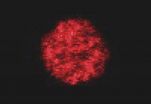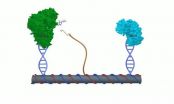(Press-News.org) An international team of scientists has made a major step forward in our understanding of how enzymes 'edit' genes, paving the way for correcting genetic diseases in patients.
Researchers at the Universities of Bristol, Münster and the Lithuanian Institute of Biotechnology have observed the process by which a class of enzymes called CRISPR – pronounced 'crisper' – bind and alter the structure of DNA.
The results, published in the Proceedings of the National Academy of Sciences (PNAS) today, provide a vital piece of the puzzle if these genome editing tools are ultimately going to be used to correct genetic diseases in humans.
CRISPR enzymes were first discovered in bacteria in the 1980s as an immune defence used by bacteria against invading viruses. Scientists have more recently shown that one type of CRISPR enzyme – Cas9 – can be used to edit the human genome - the complete set of genetic information for humans.
These enzymes have been tailored to accurately target a single combination of letters within the three billion base pairs of the DNA molecule. This is the equivalent of correcting a single misspelt word in a 23-volume encyclopaedia.
To find this needle in a haystack, CRISPR enzymes use a molecule of RNA - a nucleic acid similar in structure to DNA. The targeting process requires the CRISPR enzymes to pull apart the DNA strands and insert the RNA to form a sequence-specific structure called an 'R-loop'.
The global team tested the R-loop model using specially modified microscopes in which single DNA molecules are stretched in a magnetic field. By altering the twisting force on the DNA, the researchers could directly monitor R-loop formation events by individual CRISPR enzymes.
This allowed them to reveal previously hidden steps in the process and to probe the influence of the sequence of DNA bases.
Professor Mark Szczelkun, from Bristol University's School of Biochemistry, said: "An important challenge in exploiting these exciting genome editing tools is ensuring that only one specific location in a genome is targeted.
"Our single molecule assays have led to a greater understanding of the influence of DNA sequence on R-loop formation. In the future this will help in the rational re-engineering of CRISPR enzymes to increase their accuracy and minimise off-target effects. This will be vital if we are to ultimately apply these tools to correct genetic diseases in patients. "
INFORMATION:
The work was funded at the University of Bristol by the Biotechnology and Biological Sciences Research Council (BBSRC) and the Wellcome Trust.
Paper
'Direct observation of R-loop formation by single RNA-guided Cas9 and Cascade effector complexes' by Mark D. Szczelkuna, Maria S. Tikhomirovab, Tomas Sinkunasd, Giedrius Gasiunasd, Tautvydas Karvelisd, Patrizia Pscherac, Virginijus Siksnysd and Ralf Seidel in PNAS.
About the Biotechnology and Biological Sciences Research Council
The Biotechnology and Biological Sciences Research Council (BBSRC) invests in world-class bioscience research and training on behalf of the UK public. Our aim is to further scientific knowledge, to promote economic growth, wealth and job creation and to improve quality of life in the UK and beyond.
Funded by Government, and with an annual budget of around £467m (2012-2013), we support research and training in universities and strategically funded institutes. BBSRC research and the people we fund are helping society to meet major challenges, including food security, green energy and healthier, longer lives. Our investments underpin important UK economic sectors, such as farming, food, industrial biotechnology and pharmaceuticals.
About the Wellcome Trust
The Wellcome Trust is a global charitable foundation dedicated to achieving extraordinary improvements in human and animal health. It supports the brightest minds in biomedical research and the medical humanities. The Trust's breadth of support includes public engagement, education and the application of research to improve health. It is independent of both political and commercial interests.
Breakthrough shows how DNA is 'edited' to correct genetic diseases
2014-05-26
ELSE PRESS RELEASES FROM THIS DATE:
Sex-specific changes in cerebral blood flow begin at puberty, Penn study finds
2014-05-26
PHILADELPHIA – Puberty is the defining process of adolescent development, beginning a cascade of changes throughout the body, including the brain. Penn Medicine researchers have discovered that cerebral blood flow (CBF) levels decreased similarly in males and females before puberty, but saw them diverge sharply in puberty, with levels increasing in females while decreasing further in males, which could give hints as to developing differences in behavior in men and women and sex-specific pre-dispositions to certain psychiatric disorders. Their findings are available in Proceedings ...
A mechanism of how biodiversity arises
2014-05-26
AMHERST, Mass. – A new study of how biodiversity arises, by evolutionary biologists at the University of Massachusetts Amherst, shows how a mutation in a single gene during development can lead to different consequences not only in how animals' skull and jaw are shaped, but how this leads to different feeding strategies to exploit different ecological niches.
The study in the cichlid fish model by Yinan Hu, a doctoral student in organismic and evolutionary biology, with his advisor Craig Albertson, is among the first to address how a single genetic change can influence ...
Implications of mandatory flu vaccinations for health-care workers
2014-05-26
Employers planning to implement mandatory influenza vaccination policies for health care workers need to understand the implications, according to an analysis published in CMAJ (Canadian Medical Association Journal).
Vaccination rates among health care workers are less than 50%, well below the level necessary for herd immunity. Evidence indicates that vaccination of health care workers can benefit patient health, leading to a move by many to consider mandatory influenza vaccination as a condition of employment or to require employees to wear a mask during influenza season. ...
Neurons can use local stores for communication needs
2014-05-26
Researchers reveal that neurons can utilize a supremely localized internal store of calcium to initiate the secretion of neuropeptides, one class of signaling molecules through which neurons communicate with each other and with other cells. The study appears in The Journal of General Physiology.
Neuropeptides are released from neurons through a process that—like other secretory events—is triggered primarily by the influx of calcium into the neuron through voltage-gated channels. Although neuropeptides are stored in large dense core vesicles (LDCVs) that also contain ...
Fighting cancer with dietary changes
2014-05-26
(PHILADELPHIA) -- -- Calorie restriction, a kind of dieting in which food intake is decreased by a certain percentage, has been touted as way to help people live longer. New research suggests that there may be other benefits, including improving outcomes for women in breast cancer. According to a study published May 26th in Breast Cancer Research and Treatment, the triple negative subtype of breast cancer – one of the most aggressive forms – is less likely to spread, or metastasize, to new sites in the body when mice were fed a restricted diet.
"The diet turned on a ...
Novel drug target linked to insulin secretion and type 2 diabetes treatment
2014-05-26
This news release is available in French. A signal that promotes insulin secretion and reduces hyperglycemia in a type 2 diabetes animal model is enhanced by the inhibition of a novel enzyme discovered by CHUM Research Centre (CRCHUM) and University of Montreal researchers. The team is part of the Montreal Diabetes Research Center and their study, published recently in Cell Metabolism, was directed by researchers Marc Prentki and Murthy Madiraju.
Insulin is an important hormone in our body that controls glucose and fat utilization. Insufficient insulin release by the ...
Promising approach to slow brain degeneration in a model of Huntington's disease uncovered
2014-05-26
This news release is available in French. Research presented by Dr. Lynn Raymond, from the University of British Columbia, shows that blocking a specific class of glutamate receptors, called extrasynaptic NMDA receptors, can improve motor learning and coordination, and prevent cell death in animal models of Huntington disease. As Huntington disease is an inherited condition that can be detected decades before any clinical symptoms are seen in humans, a better understanding of the earliest changes in brain cell (neuronal) function, and the molecular pathways underlying ...
The Lancet Oncology: UN officials warn refugees are struggling to access cancer treatment
2014-05-26
A study published in The Lancet Oncology journal reveals a high demand for costly cancer treatment among refugees from the recent conflicts in Iraq and Syria, with host countries struggling to find the money and the medicine to treat their new patients. The findings have prompted calls from lead author Dr Paul Spiegel, the United Nations High Commissioner for Refugees (UNHCR) Chief Medical Expert, for innovative financing schemes to improve access to affordable high-quality cancer care for refugees.
In the first study of its kind, Spiegel and colleagues examined data ...
A new molecule for high-resolution cell imaging
2014-05-25
Like our own bodies, cells have their own skeletons called 'cytoskeletons' and are made of proteins instead of bones. These network-like structures maintain the cell's shape, provide mechanical support, and are involved in critical processes of the cell's lifecycle. The cytoskeleton is an object of intense scientific and medical research, which often requires being able to observe it directly in cells. Ideally, this would involve highly-fluorescent molecules that can bind cytoskeletal proteins with high specificity without being toxic to the cell. Publishing in Nature Methods, ...
DNA nanotechnology places enzyme catalysis within an arm's length
2014-05-25
VIDEO:
In the middle of a DNA scaffold is affixed a single strand of DNA, with NAD+ tethered to the end like a ball and string. ASU Professor Han Yan refers...
Click here for more information.
Using molecules of DNA like an architectural scaffold, Arizona State University scientists, in collaboration with colleagues at the University of Michigan, have developed a 3-D artificial enzyme cascade that mimics an important biochemical pathway that could prove important for future biomedical ...



